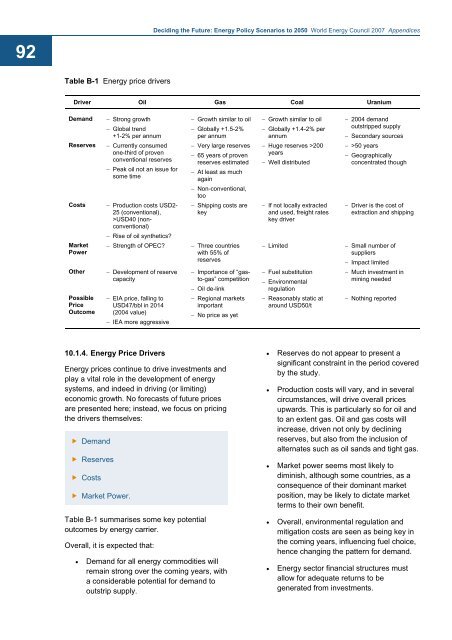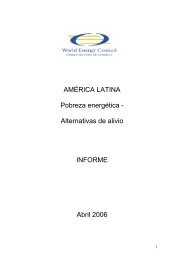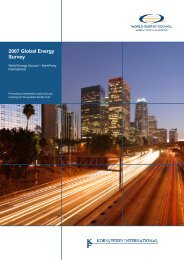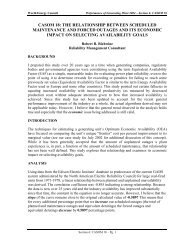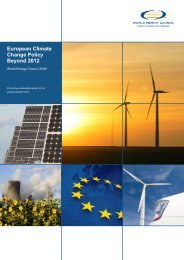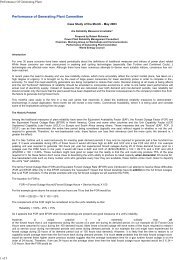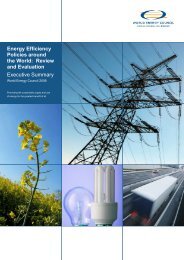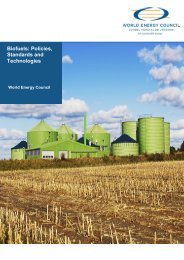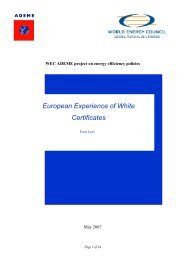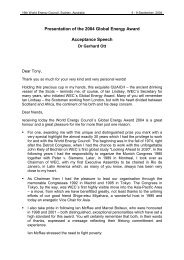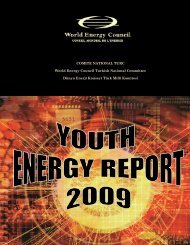Deciding the Future: Energy Policy Scenarios to 2050
Deciding the Future: Energy Policy Scenarios to 2050
Deciding the Future: Energy Policy Scenarios to 2050
Create successful ePaper yourself
Turn your PDF publications into a flip-book with our unique Google optimized e-Paper software.
92<br />
<strong>Deciding</strong> <strong>the</strong> <strong>Future</strong>: <strong>Energy</strong> <strong>Policy</strong> <strong>Scenarios</strong> <strong>to</strong> <strong>2050</strong> World <strong>Energy</strong> Council 2007 Appendices<br />
Table B-1 <strong>Energy</strong> price drivers<br />
Driver Oil Gas Coal Uranium<br />
Demand<br />
Reserves<br />
Costs<br />
Market<br />
Power<br />
O<strong>the</strong>r<br />
Possible<br />
Price<br />
Outcome<br />
− Strong growth<br />
− Global trend<br />
+1-2% per annum<br />
− Currently consumed<br />
one-third of proven<br />
conventional reserves<br />
− Peak oil not an issue for<br />
some time<br />
− Production costs USD2-<br />
25 (conventional),<br />
>USD40 (nonconventional)<br />
− Rise of oil syn<strong>the</strong>tics?<br />
− Strength of OPEC?<br />
− Development of reserve<br />
capacity<br />
− EIA price, falling <strong>to</strong><br />
USD47/bbl in 2014<br />
(2004 value)<br />
− IEA more aggressive<br />
− Growth similar <strong>to</strong> oil<br />
− Globally +1.5-2%<br />
per annum<br />
− Very large reserves<br />
− 65 years of proven<br />
reserves estimated<br />
− At least as much<br />
again<br />
− Non-conventional,<br />
<strong>to</strong>o<br />
− Shipping costs are<br />
key<br />
− Three countries<br />
with 55% of<br />
reserves<br />
− Importance of “gas<strong>to</strong>-gas”<br />
competition<br />
− Oil de-link<br />
− Regional markets<br />
important<br />
− No price as yet<br />
− Growth similar <strong>to</strong> oil<br />
− Globally +1.4-2% per<br />
annum<br />
− Huge reserves >200<br />
years<br />
− Well distributed<br />
− If not locally extracted<br />
and used, freight rates<br />
key driver<br />
− Limited<br />
− Fuel substitution<br />
− Environmental<br />
regulation<br />
− Reasonably static at<br />
around USD50/t<br />
− 2004 demand<br />
outstripped supply<br />
− Secondary sources<br />
− >50 years<br />
− Geographically<br />
concentrated though<br />
− Driver is <strong>the</strong> cost of<br />
extraction and shipping<br />
− Small number of<br />
suppliers<br />
− Impact limited<br />
− Much investment in<br />
mining needed<br />
− Nothing reported<br />
10.1.4. <strong>Energy</strong> Price Drivers<br />
<strong>Energy</strong> prices continue <strong>to</strong> drive investments and<br />
play a vital role in <strong>the</strong> development of energy<br />
systems, and indeed in driving (or limiting)<br />
economic growth. No forecasts of future prices<br />
are presented here; instead, we focus on pricing<br />
<strong>the</strong> drivers <strong>the</strong>mselves:<br />
Demand<br />
Reserves<br />
Costs<br />
Market Power.<br />
Table B-1 summarises some key potential<br />
outcomes by energy carrier.<br />
Overall, it is expected that:<br />
• Demand for all energy commodities will<br />
remain strong over <strong>the</strong> coming years, with<br />
a considerable potential for demand <strong>to</strong><br />
outstrip supply.<br />
• Reserves do not appear <strong>to</strong> present a<br />
significant constraint in <strong>the</strong> period covered<br />
by <strong>the</strong> study.<br />
• Production costs will vary, and in several<br />
circumstances, will drive overall prices<br />
upwards. This is particularly so for oil and<br />
<strong>to</strong> an extent gas. Oil and gas costs will<br />
increase, driven not only by declining<br />
reserves, but also from <strong>the</strong> inclusion of<br />
alternates such as oil sands and tight gas.<br />
• Market power seems most likely <strong>to</strong><br />
diminish, although some countries, as a<br />
consequence of <strong>the</strong>ir dominant market<br />
position, may be likely <strong>to</strong> dictate market<br />
terms <strong>to</strong> <strong>the</strong>ir own benefit.<br />
• Overall, environmental regulation and<br />
mitigation costs are seen as being key in<br />
<strong>the</strong> coming years, influencing fuel choice,<br />
hence changing <strong>the</strong> pattern for demand.<br />
• <strong>Energy</strong> sec<strong>to</strong>r financial structures must<br />
allow for adequate returns <strong>to</strong> be<br />
generated from investments.


